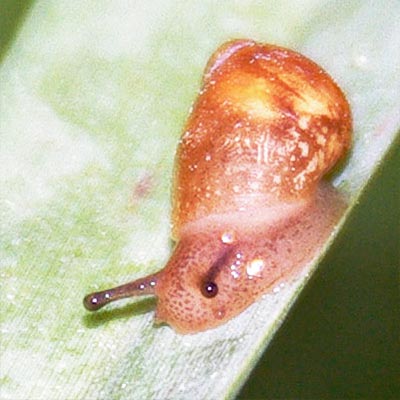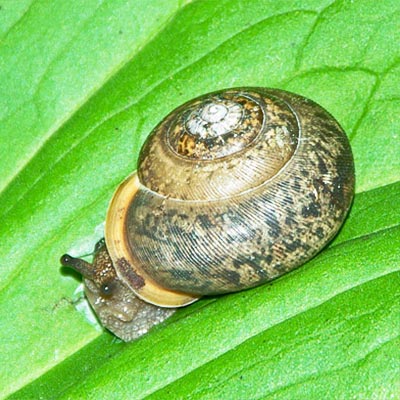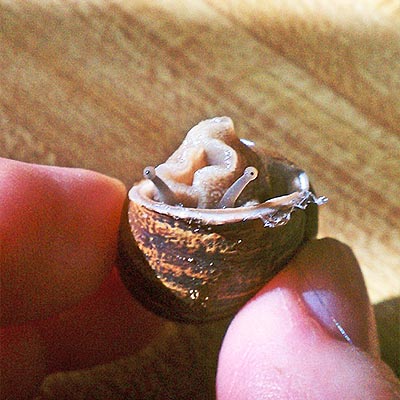Greetings, BugFans,
Warning: This BOTW carries an X-Rating, due to intimate details about the courtship of terrestrial snails (Love Darts, Guys/Gals? Seriously?). Impressionable Youth—keep reading. Love darts. It also carries a NFTFOH (Not for the Faint of Heart) warning.
Today’s BOTW moseys out of Arthropod territory once again, back into the realm of the one-footed (novice BugFans please note—for our purposes, the definition of “bug” is a bit… well… nebulous). The BugLady doesn’t know the names of the snails pictured.
Land snails dwell in the phylum Mollusca, in the class Gastropoda (which means belly foot). Mollusks are soft-bodied animals whose mantle secretes a limy shell, an arrangement that has served them well for 500 million years. Of the 100,000 (to 200,000) species of Gastropods, 75% are aquatic. Eastern North America accounts for 500 species of land snails, of which Wisconsin has 100. Some land snails occur on vegetation pretty close to water, but others are found in gardens, forest floors, and cities.
The life history of terrestrial snails is pretty straightforward.
Externally: The muscular portion of the snail below its abdomen is called the “foot.” Snails move via undulating contractions of muscles across the bottom of the foot (from fore to aft, kind of like “the Wave”), assisted by the action of tiny hair-like cilia. This set-up, coupled with slick mucous produced in the foot, allows snails to traverse just about any kind of terrain; there are pictures of snails climbing up and over the business end of a razor. A second type of mucous, also produced in the foot, keeps snails from drying out.
They have two pairs of “feelers” (tentacles); a long pair that is tipped by the snail’s eyes, and a short pair located below the first (aquatic snails have just two tentacles, with eyes located at the base). The eyes of most species of snails are only good for discerning light from dark. Its shorter tentacles allow a snail to decipher the world via touch and via chemoreceptors for smell and taste. If you poke them in the eye, they can retract the eyestalk instantly.
The shell. Snails prefer a calcium-rich environment. They may take in calcium in the food they eat, or they may ingest “straight” calcium in the form of bones, deer antlers, calcium-rich rocks, and even the snail shells (sometimes while they’re still occupied). Calcium is then secreted by an organ called the mantle, a thin layer of multi-tasking tissue that is attached to the shell and that delivers the limey material that hardens into new shell. New shell is added at the shell’s opening; the shell’s center is its oldest part.
Internally: Most land snails have a “lung” (a cavity connected to the outside by a respiratory pore and served by lots of blood vessels), a digestive cavity, a heart, and a primitive brain and a few other interesting accoutrements.
With a few exceptions, land snails are generalist vegetarians/decomposers. They have a raspy tongue called a radula with which they scrape off pieces of leaves, soft bark, fruits, algae, fungi, etc; these bits are moved into their esophagus and then digested. You can key snails down based on the arrangement of rasps/teeth on the radula or by looking at the “dental pattern” they leave on the plants they rasp.
They are eaten by many invertebrates (including carnivorous snails), and their vertebrate predators include reptiles, amphibians, small mammals, song birds, and game birds (turkeys love them). Along with protein, their predators score a beneficial dose of calcium. Snails protect themselves by pulling their foot back into their shell (most terrestrial species don’t have a “trap door” (operculum) to pull in after themselves) and by cryptic coloration, bad odors, or by a nasty taste.
[metaslider id=4397]
NFTFOH: Avert your eyes, Patrick. The BugLady did find one amazing snail parasite. She is not sure whether this scene is playing out locally, but both the affected (afflicted) ambersnail genus and the parasite occur in North America, and the BugLady knows that BugFans want to embrace all aspects of Nature. Leucochloridium paradoxum, a parasitic flatworm, needs two hosts in order to mature, a songbird and a snail. Mini-flatworms are ingested by a snail that eats bird poop, and within the snail they start to grow. The flatworm has solved the “How-Do-I-Get-Inside-a-Bird?” problem ingeniously. It produces long, colorful tubes called sporocysts (brood sacs) that grow out into the snail’s eye tentacle (preferably the left tentacle, according to several sources). The tentacle gets too thick to be retracted. The sporocyst affects the snail’s light perception so that it stays out in the daylight, and as a finishing touch, the sporocyst starts to pulsate on the motionless snail (it’s photosensitive and doesn’t move in the dark). The snail’s cover is blown; birds think the tentacle is a caterpillar and eat the whole shebang. Of course, there are tons of animations, videos, photographs, and YouTube submissions of this phenomenon for our edification.
Love Darts: Finally. The vast majority of snails (and slugs) are hermaphroditic; that is, each individual has both male and female reproductive organs, but they do need to exchange bodily fluids with another individual in order to produce eggs. A snail’s world is a tactile world and so is their courtship, which may last for half a day, of stroking and nibbling. In many families of land snails, each suitor tries to fire a “love dart” (glypsobelum) point blank into the other’s body as the prospective partners sidle past each other in the heat of courtship. Produced within the snail’s body and usually constructed of calcium carbonate, the love dart is long and sharp and has been likened to a harpoon. (The BugLady couldn’t possibly make this stuff up!)
Scientists used to think that sperm material was transferred with the darts, but that is not the case. The dart, delivered under considerable hydrostatic pressure, introduces a hormone-like chemical that increases the survival rate of the sperm that are subsequently delivered to a lateral reproductive opening. After fertilization, both snails lay eggs in the soil. When they hatch, the transparent snailettes already have a weak mini-shell which they strengthen by eating their own egg shell. Most species aren’t sexually mature for at least a year.
Alien Snails: Humans are also on the list of snail predators. The science of snail farming is called Heliciculture. In service of people’s taste for snails/escargot, snails have been carted to snail farms at the far corners of the earth. The Wikipedia entry on “Heliciculture” includes a list of edible snail species, their origins, and their present locations. Snails are slippery little devils, and some always manage to escape. Back in the 1920’s or ‘30’s, a snail farm was developed on an island in the Milwaukee River on the north side of Milwaukee County. The river flooded, and the breeding stock were swept away. Visitors to parks downstream today are startled by fist-sized snails munching on the plants. If you want to start a snail farm these days, you’ll need a pocketful of State and Federal permits and some impenetrable enclosures.
The exotic pet trade: Snails don’t bark or scratch or shed or need rabies shots, so they often end up in homes and classrooms. A popular (and highly illegal) pet species is the African Land Snail (Ghana Tiger Snail), which may grow to be a foot long. In 1966, a (very fertile) African Land snail was smuggled back to Miami and set outside to be a garden snail. By the early ‘70’s, there were 18,000 African snails in the area and it took 10 years to eradicate them. In 2003-04, the USDA seized African land snails from a number of classrooms in Wisconsin. Not only are these snails hard on native vegetation, they can carry diseases in their mucous.
Snails are also farmed and their slime harvested for medical and cosmetic products (see Today’s report at Snailed it! Snail-slime face cream is hot beauty trend).
And then there’s horticulture: BugFan Joan found Postersnail in her store-bought rosemary shrub, which was purchased here in God’s Country. The plant and its soil originated in California. See how easy that is??
And if you want to order snails in a British restaurant, ask for the “Wall Fish.”
The BugLady


